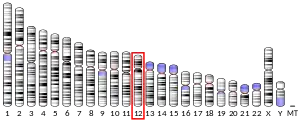Coronin-1C is a protein that in humans is encoded by the CORO1C gene.[5][6][7]
This gene encodes a member of the WD repeat protein family. WD repeats are minimally conserved regions of approximately 40 amino acids typically bracketed by gly-his and trp-asp (GH-WD), which may facilitate formation of heterotrimeric or multiprotein complexes. Members of this family are involved in a variety of cellular processes, including cell cycle progression, signal transduction, apoptosis, and gene regulation.[7]
References
- 1 2 3 GRCh38: Ensembl release 89: ENSG00000110880 - Ensembl, May 2017
- 1 2 3 GRCm38: Ensembl release 89: ENSMUSG00000004530 - Ensembl, May 2017
- ↑ "Human PubMed Reference:". National Center for Biotechnology Information, U.S. National Library of Medicine.
- ↑ "Mouse PubMed Reference:". National Center for Biotechnology Information, U.S. National Library of Medicine.
- ↑ Okumura M, Kung C, Wong S, Rodgers M, Thomas ML (Oct 1998). "Definition of family of coronin-related proteins conserved between humans and mice: close genetic linkage between coronin-2 and CD45-associated protein". DNA Cell Biol. 17 (9): 779–87. doi:10.1089/dna.1998.17.779. PMID 9778037.
- ↑ de Hostos EL (Oct 1999). "The coronin family of actin-associated proteins". Trends Cell Biol. 9 (9): 345–50. doi:10.1016/S0962-8924(99)01620-7. PMID 10461187.
- 1 2 "Entrez Gene: CORO1C coronin, actin binding protein, 1C".
External links
- Human CORO1C genome location and CORO1C gene details page in the UCSC Genome Browser.
Further reading
- Rosentreter A, Hofmann A, Xavier CP, et al. (2007). "Coronin 3 involvement in F-actin-dependent processes at the cell cortex". Exp. Cell Res. 313 (5): 878–95. doi:10.1016/j.yexcr.2006.12.015. hdl:10072/14982. PMID 17274980.
- Rush J, Moritz A, Lee KA, et al. (2005). "Immunoaffinity profiling of tyrosine phosphorylation in cancer cells". Nat. Biotechnol. 23 (1): 94–101. doi:10.1038/nbt1046. PMID 15592455. S2CID 7200157.
- Gerhard DS, Wagner L, Feingold EA, et al. (2004). "The Status, Quality, and Expansion of the NIH Full-Length cDNA Project: The Mammalian Gene Collection (MGC)". Genome Res. 14 (10B): 2121–7. doi:10.1101/gr.2596504. PMC 528928. PMID 15489334.
- Ota T, Suzuki Y, Nishikawa T, et al. (2004). "Complete sequencing and characterization of 21,243 full-length human cDNAs". Nat. Genet. 36 (1): 40–5. doi:10.1038/ng1285. PMID 14702039.
- Strausberg RL, Feingold EA, Grouse LH, et al. (2003). "Generation and initial analysis of more than 15,000 full-length human and mouse cDNA sequences". Proc. Natl. Acad. Sci. U.S.A. 99 (26): 16899–903. Bibcode:2002PNAS...9916899M. doi:10.1073/pnas.242603899. PMC 139241. PMID 12477932.
- Spoerl Z, Stumpf M, Noegel AA, Hasse A (2003). "Oligomerization, F-actin interaction, and membrane association of the ubiquitous mammalian coronin 3 are mediated by its carboxyl terminus". J. Biol. Chem. 277 (50): 48858–67. doi:10.1074/jbc.M205136200. PMID 12377779.
- Iizaka M, Han HJ, Akashi H, et al. (2000). "Isolation and chromosomal assignment of a novel human gene, CORO1C, homologous to coronin-like actin-binding proteins". Cytogenet. Cell Genet. 88 (3–4): 221–4. doi:10.1159/000015555. PMID 10828594. S2CID 46548464.
- Suzuki Y, Yoshitomo-Nakagawa K, Maruyama K, et al. (1997). "Construction and characterization of a full length-enriched and a 5'-end-enriched cDNA library". Gene. 200 (1–2): 149–56. doi:10.1016/S0378-1119(97)00411-3. PMID 9373149.
- Wick M, Bürger C, Brüsselbach S, et al. (1994). "Identification of serum-inducible genes: different patterns of gene regulation during G0-->S and G1-->S progression". J. Cell Sci. 107 (1): 227–39. doi:10.1242/jcs.107.1.227. PMID 8175911.
- Maruyama K, Sugano S (1994). "Oligo-capping: a simple method to replace the cap structure of eukaryotic mRNAs with oligoribonucleotides". Gene. 138 (1–2): 171–4. doi:10.1016/0378-1119(94)90802-8. PMID 8125298.
This article is issued from Wikipedia. The text is licensed under Creative Commons - Attribution - Sharealike. Additional terms may apply for the media files.




